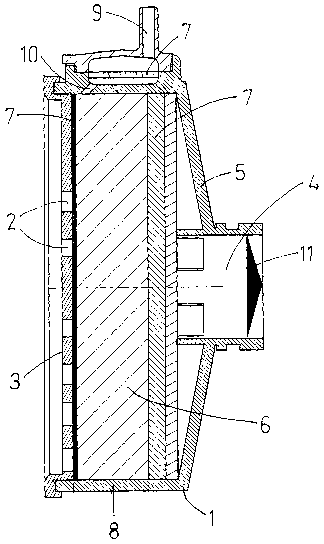Some of the information on this Web page has been provided by external sources. The Government of Canada is not responsible for the accuracy, reliability or currency of the information supplied by external sources. Users wishing to rely upon this information should consult directly with the source of the information. Content provided by external sources is not subject to official languages, privacy and accessibility requirements.
Any discrepancies in the text and image of the Claims and Abstract are due to differing posting times. Text of the Claims and Abstract are posted:
| (12) Patent Application: | (11) CA 2498714 |
|---|---|
| (54) English Title: | SCRUBBER |
| (54) French Title: | EPURATEUR |
| Status: | Deemed Abandoned and Beyond the Period of Reinstatement - Pending Response to Notice of Disregarded Communication |
| (51) International Patent Classification (IPC): |
|
|---|---|
| (72) Inventors : |
|
| (73) Owners : |
|
| (71) Applicants : |
|
| (74) Agent: | GOWLING WLG (CANADA) LLP |
| (74) Associate agent: | |
| (45) Issued: | |
| (86) PCT Filing Date: | 2003-08-21 |
| (87) Open to Public Inspection: | 2004-03-25 |
| Examination requested: | 2008-06-03 |
| Availability of licence: | N/A |
| Dedicated to the Public: | N/A |
| (25) Language of filing: | English |
| Patent Cooperation Treaty (PCT): | Yes |
|---|---|
| (86) PCT Filing Number: | PCT/SE2003/001299 |
| (87) International Publication Number: | WO 2004023998 |
| (85) National Entry: | 2005-03-11 |
| (30) Application Priority Data: | |||||||||
|---|---|---|---|---|---|---|---|---|---|
|
A scrubber for eliminating NO from air flowing through the scrubber,
comprising a housing (1) having at least one inlet hole (2) and an outlet hole
(4) and which is comprising filtering material (6). A second outlet hole (9)
is provided in the housing (1) at a position situated at a distance from the
first outlet hole (4) and any inlet hole (2) so that the air leaving the
second outlet hole (9) will have flown at least through a depth of the
filtering material (6) substantially corresponding to the depth of the
filtering material (6) for the air flowing from the inlet hole (2) to the
first outlet hole (4).
Cette invention se rapporte à un épurateur servant à éliminer le NO de l'air traversant l'épurateur, lequel comprend un logement (1) comportant au moins un orifice d'admission (2) et un orifice d'émission (4) et constitué par un matériau filtrant (6). Un second orifice d'émission (9) est ménagé dans le logement (1) dans une position située à une certaine distance du premier orifice d'émission (4) et du ou des orifices d'admission (2), pour que l'air quittant le second orifice d'admission (9) ait traversé au moins une épaisseur du matériau filtrant (6) correspondant sensiblement à l'épaisseur du matériau filtrant (6) traversé par l'air s'écoulant de l'orifice d'admission (2) jusqu'au premier orifice d'émission (4).
Note: Claims are shown in the official language in which they were submitted.
Note: Descriptions are shown in the official language in which they were submitted.

2024-08-01:As part of the Next Generation Patents (NGP) transition, the Canadian Patents Database (CPD) now contains a more detailed Event History, which replicates the Event Log of our new back-office solution.
Please note that "Inactive:" events refers to events no longer in use in our new back-office solution.
For a clearer understanding of the status of the application/patent presented on this page, the site Disclaimer , as well as the definitions for Patent , Event History , Maintenance Fee and Payment History should be consulted.
| Description | Date |
|---|---|
| Application Not Reinstated by Deadline | 2011-08-22 |
| Time Limit for Reversal Expired | 2011-08-22 |
| Deemed Abandoned - Failure to Respond to Maintenance Fee Notice | 2010-08-23 |
| Amendment Received - Voluntary Amendment | 2008-09-22 |
| Letter Sent | 2008-08-18 |
| Request for Examination Received | 2008-06-03 |
| All Requirements for Examination Determined Compliant | 2008-06-03 |
| Request for Examination Requirements Determined Compliant | 2008-06-03 |
| Inactive: IPC from MCD | 2006-03-12 |
| Letter Sent | 2005-06-06 |
| Inactive: Cover page published | 2005-05-30 |
| Inactive: Notice - National entry - No RFE | 2005-05-24 |
| Inactive: Single transfer | 2005-05-02 |
| Application Received - PCT | 2005-04-04 |
| National Entry Requirements Determined Compliant | 2005-03-11 |
| Application Published (Open to Public Inspection) | 2004-03-25 |
| Abandonment Date | Reason | Reinstatement Date |
|---|---|---|
| 2010-08-23 |
The last payment was received on 2009-08-07
Note : If the full payment has not been received on or before the date indicated, a further fee may be required which may be one of the following
Please refer to the CIPO Patent Fees web page to see all current fee amounts.
| Fee Type | Anniversary Year | Due Date | Paid Date |
|---|---|---|---|
| Basic national fee - standard | 2005-03-11 | ||
| Registration of a document | 2005-05-02 | ||
| MF (application, 2nd anniv.) - standard | 02 | 2005-08-22 | 2005-07-28 |
| MF (application, 3rd anniv.) - standard | 03 | 2006-08-21 | 2006-07-24 |
| MF (application, 4th anniv.) - standard | 04 | 2007-08-21 | 2007-08-07 |
| Request for examination - standard | 2008-06-03 | ||
| MF (application, 5th anniv.) - standard | 05 | 2008-08-21 | 2008-08-01 |
| MF (application, 6th anniv.) - standard | 06 | 2009-08-21 | 2009-08-07 |
Note: Records showing the ownership history in alphabetical order.
| Current Owners on Record |
|---|
| AEROCRINE AB |
| Past Owners on Record |
|---|
| MIKAEL NILSSON |
| TRYGGVE HEMMINGSSON |